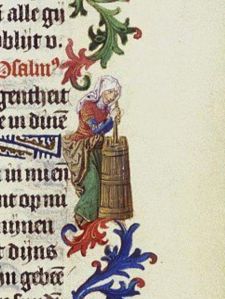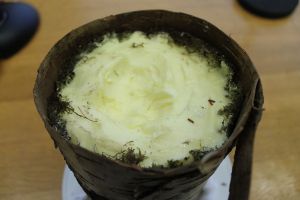
“Some humans would do anything to see if it was possible to do it. If you put a large switch in some cave somewhere, with a sign on it saying ‘End-of-the-World Switch. PLEASE DO NOT TOUCH’, the paint wouldn’t even have time to dry.”
– Terry Pratchett, Thief of Time
Humans are a funny lot. There always seems to be someone who would say “I wonder what this does?” or “I wonder what that tastes like?” There seem to have been quite a number of people who will eat all kinds of weird things, from William Buckland, who ate the heart of Louis XVI, to the two men who, during the Great Fire of London, took the opportunity to taste the liquid in the coffin of a former Dean of St Paul’s Cathedral, to the people who paid a modern artist to cook and serve his own genitalia to them. Human curiosity apparently knows no bounds!
Today, though, I want to talk about something a little less disgusting than cannibalism – I want to talk about bog butter.

Irish bog
Muddy, water-saturated lands known as ‘bogs‘ are commonplace in Ireland, Scotland, and across the world. Mosses – particularly sphagnum moss – grow plentifully, and never decay entirely in the oxygen-deprived stagnant waters. Over time, the dead plants slowly form into peat, and humans have been exploiting this natural resource for many years. Dried peat is esteemed by whisky-lovers and gardeners, and is a traditional source of fuel. For thousands of years peat has been dug out, dried, and used on fires, and it still accounts for 6% of Ireland’s energy today.

Tollund Man
For as far back as history goes, humans have worked in the bogs, collecting peat, and peat-diggers are often the ones who have found…other things in there. Incredibly well-preserved human remains dating back to 8000BC have been discovered, along with jewellery, clothing and other items. It’s fairly easy to understand why you might put a body in a bog – either as sacrifice, punishment or to hide a murder victim, but what seems slightly odd is that butter has also been discovered.
 On a fairly regular basis, peat-cutters turn up buckets, bowls, churns, baskets and boxes in the bogs, as well as packages wrapped in bark, skins, intestines and cloths. When opened, a waxy substance is revealed with a buttery/cheesy smell. When tested, it’s almost always discovered to be actual butter, and occasionally other animal fats.
On a fairly regular basis, peat-cutters turn up buckets, bowls, churns, baskets and boxes in the bogs, as well as packages wrapped in bark, skins, intestines and cloths. When opened, a waxy substance is revealed with a buttery/cheesy smell. When tested, it’s almost always discovered to be actual butter, and occasionally other animal fats.
So why would you put butter in a bog?
Butter is a common food now, and readily available, but it wasn’t quite as common for our ancestors. In the hot climate of the Mediterranean butter went rancid very quickly, and so it wasn’t much used there. In fact, the ancient Greeks and Romans were quite sniffy about butter-eating, seeing it as a barbarian thing, something that might be good for medicine, but not for eating. Their insult for barbarian tribes was “boutyrophagoi” (“butter-eaters”). Further east, the butter used was ghee – clarified butter – which has a longer shelf life, and is used for religious and medicinal reasons there, as well as cooking.

Mediaeval butter-making
Butter as we know it was used more in Northern Europe than elsewhere. Butter is best made in cooler climates, and the northern peoples ate rather a lot of butter – and their fondness for it spread until, by the 12th century, there was a demand. Once butter became popular, it started being used as payment for taxes, fines, and rents. The magnificent Tour de Beurre of Rouen Cathedral was financed by the tithes paid so that people could eat butter during Lent, and butter was so central to the Irish economy that the Butter Exchange was built in Cork to help regulate the trade.
You wouldn’t want to waste butter, to have it go off because you had made too much for yourself, or because you weren’t able to trade it at that time. At some point, people had discovered that peat bogs were quite good at preserving things – such as the bodies I mentioned earlier. Burying food to preserve it is quite common across the world – things like eggs (China), cheese (Italy), milk (Norway), seabirds (Inuit), fish (Norway) and cabbage (Austria) as well as fermented products like wine and soy sauce. The oxygen-deprived atmosphere of a bog means that things decay extremely slowly – and some of the butter packages that have been found date to c400BC!

Bog butter
The bogs preserved the butter, and also hid it – from thieves, or possibly the taxman! (This may also be why we find so much butter – people couldn’t find it to retrieve it).
I began this article by saying that some people will eat anything….quite a few people have tried ancient bog butter (including a group of schoolchildren) and some people have made their own. Apparently the taste is somewhat different from fresh butter, more reminiscent of cheese, gamey and pungent. It is perfectly edible, though not to everyone’s taste. It is possible that those who buried it originally preferred the ‘mature’ taste of the butter, and that that was one of their reasons for sinking fresh butter into a bog.

Children with bog butter
So there you have it, amazingly still-edible foodstuffs dug up from peat bogs. It’s not actually the preservation of the ancient butter that surprises me – what I find weird is this insatiable urge some people have to taste something they dug out of there! People are strange. I’ll end with another quote from Terry Pratchett, and some links so you can make your own bog butter, should you want to!
‘And there’s the sign, Ridcully,’ said the Dean. ‘You have read it, I assume. You know? The sign which says “Do not, under any circumstances, open this door”?’
‘Of course I’ve read it,’ said Ridcully. ‘Why d’yer think I want it opened?’
‘Er … why?’ said the Lecturer in Recent Runes.
‘To see why they wanted it shut, of course.’
This exchange contains almost all you need to know about human civilization. At least, those bits of it that are now under the sea, fenced off or still smoking.”
-Terry Pratchett, Hogfather
Further Reading
- Bog butter: a gastronomic perspective – the history of bog butter, plus making it!
- Bog Butter – Restoring Mayberry. Another go at making bog butter.
- The History of Butter – The Butter Journal.
- Buried Butter – Pathways to Cultural Landscapes
- Europe’s Famed Bog Bodies Are Starting to Reveal Their Secrets – The Smithsonian Magazine
- Bog Body – Wikipedia